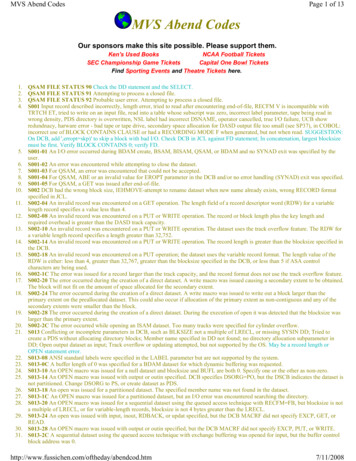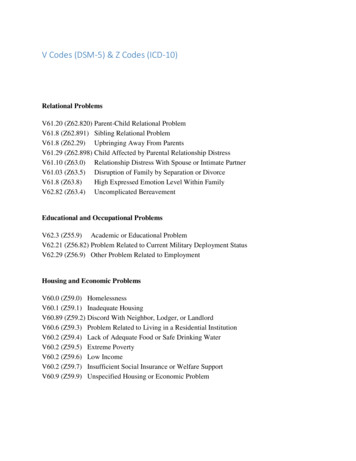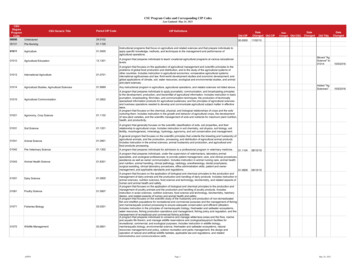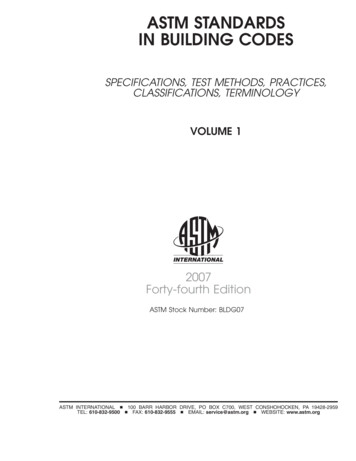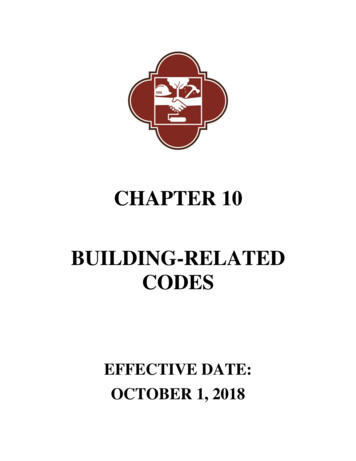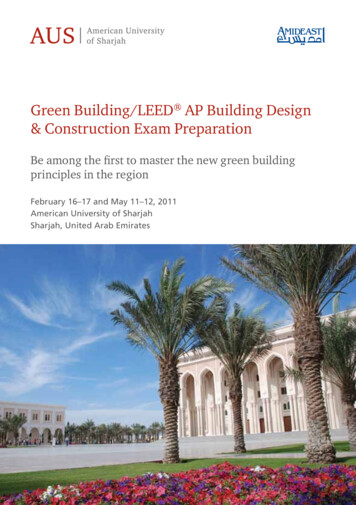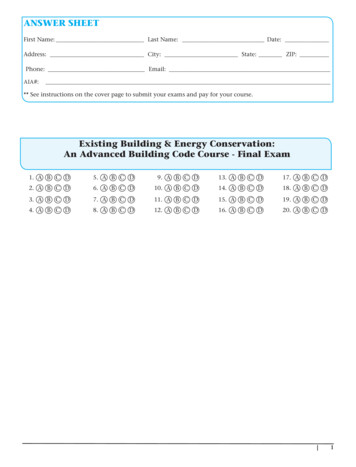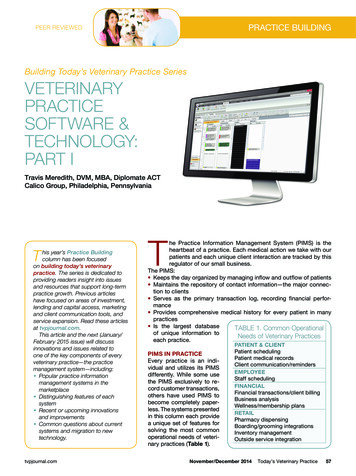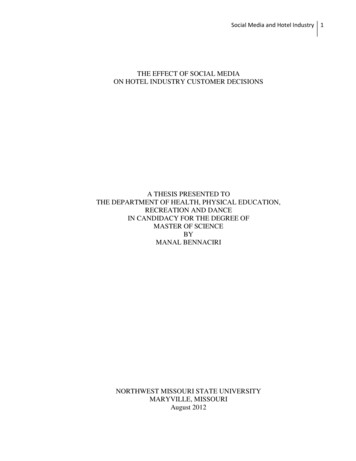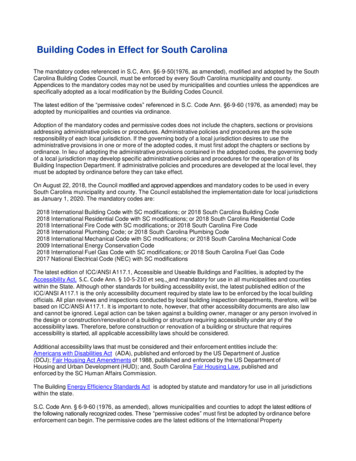
Transcription
Building Codes in Effect for South CarolinaThe mandatory codes referenced in S.C, Ann. §6-9-50(1976, as amended), modified and adopted by the SouthCarolina Building Codes Council, must be enforced by every South Carolina municipality and county.Appendices to the mandatory codes may not be used by municipalities and counties unless the appendices arespecifically adopted as a local modification by the Building Codes Council.The latest edition of the “permissive codes” referenced in S.C. Code Ann. §6-9-60 (1976, as amended) may beadopted by municipalities and counties via ordinance.Adoption of the mandatory codes and permissive codes does not include the chapters, sections or provisionsaddressing administrative policies or procedures. Administrative policies and procedures are the soleresponsibility of each local jurisdiction. If the governing body of a local jurisdiction desires to use theadministrative provisions in one or more of the adopted codes, it must first adopt the chapters or sections byordinance. In lieu of adopting the administrative provisions contained in the adopted codes, the governing bodyof a local jurisdiction may develop specific administrative policies and procedures for the operation of itsBuilding Inspection Department. If administrative policies and procedures are developed at the local level, theymust be adopted by ordinance before they can take effect.On August 22, 2018, the Council modified and approved appendices and mandatory codes to be used in everySouth Carolina municipality and county. The Council established the implementation date for local jurisdictionsas January 1, 2020. The mandatory codes are:2018 International Building Code with SC modifications; or 2018 South Carolina Building Code2018 International Residential Code with SC modifications; or 2018 South Carolina Residential Code2018 International Fire Code with SC modifications; or 2018 South Carolina Fire Code2018 International Plumbing Code; or 2018 South Carolina Plumbing Code2018 International Mechanical Code with SC modifications; or 2018 South Carolina Mechanical Code2009 International Energy Conservation Code2018 International Fuel Gas Code with SC modifications; or 2018 South Carolina Fuel Gas Code2017 National Electrical Code (NEC) with SC modificationsThe latest edition of ICC/ANSI A117.1, Accessible and Useable Buildings and Facilities, is adopted by theAccessibility Act, S.C. Code Ann. § 10-5-210 et seq., and mandatory for use in all municipalities and countieswithin the State. Although other standards for building accessibility exist, the latest published edition of theICC/ANSI A117.1 is the only accessibility document required by state law to be enforced by the local buildingofficials. All plan reviews and inspections conducted by local building inspection departments, therefore, will bebased on ICC/ANSI A117.1. It is important to note, however, that other accessibility documents are also lawand cannot be ignored. Legal action can be taken against a building owner, manager or any person involved inthe design or construction/renovation of a building or structure requiring accessibility under any of theaccessibility laws. Therefore, before construction or renovation of a building or structure that requiresaccessibility is started, all applicable accessibility laws should be considered.Additional accessibility laws that must be considered and their enforcement entities include the:Americans with Disabilities Act (ADA), published and enforced by the US Department of Justice(DOJ); Fair Housing Act Amendments of 1988, published and enforced by the US Department ofHousing and Urban Development (HUD); and, South Carolina Fair Housing Law, published andenforced by the SC Human Affairs Commission.The Building Energy Efficiency Standards Act is adopted by statute and mandatory for use in all jurisdictionswithin the state.S.C. Code Ann. § 6-9-60 (1976, as amended), allows municipalities and counties to adopt the latest editions ofthe following nationally recognized codes. These “permissive codes” must first be adopted by ordinance beforeenforcement can begin. The permissive codes are the latest editions of the International Property
Maintenance Code; International Existing Building Code; International Performance Code; and InternationalSwimming Pool and Spa Code(Note that while the International Existing Building Code is a permissive codein South Carolina, this code was adopted by reference in the International Building Code (Chapter 34 ) whichis a mandatory code. In 2012, the Council moved this International Building Code reference to theInternational Existing Building Code to Chapter 1 Administration, Section 101.4.7 of the South CarolinaBuilding Code. As such, the South Carolina Existing Code is still a permissive code).Order copies of the International Codes, the National Electrical Code, or the ICC/ANSI A117.1 document.Code Adoption History:The following information is provided for research purposes and may be used to verify the official dates forwhich local jurisdictions were or are required to enforce certain editions of the mandatory building codes.The International Code Series was developed as a joint project by the Southern Building Code Congress,International, the International Conference of Building Officials and the Building Officials and CodeAdministrators, International (referred to as model code organizations) and replaced the Standard, Nationaland Uniform Building Code Series. The 1997 Editions of the Standard, National and Uniform Codes (whichwere regional), and the 1995 Edition of the CABO One and Two Family Dwelling Code (which was national),were the last to be published. The International Building Code Series replaced those documents and provideda single set of National Codes. Simultaneously, the three model code organizations merged and created theInternational Code Council. All codes, training, and Code Enforcement Officer Certification examinations for theState of South Carolina are now based on the International Code series.Prior to June 13, 1997, local jurisdictions that desired to adopt building codes were permitted to do so by localordinance. If a jurisdiction did adopt building codes, it was required to adopt only the codes authorized by theBuilding Codes Act. Once adopted, the jurisdiction was obligated to continue the adoption of each new editionwithin one year after it was made available by the publisher. The implementation date for enforcement wasestablished by the local jurisdiction.Starting July 13, 1997, all local jurisdictions that did not legally “opt-out” of the mandatory building codeprogram were required to adopt building codes by local ordinance, after they were authorized by the Council.The Council was also required to establish the date of implementation for each of the adopted codes.Beginning July 2, 2003, the Council was charged with the responsibility for adopting all mandatory buildingcodes and establishing the date of implementation for the local jurisdictions.Starting with the 2006 code adoption cycle, the Council, instead of the local jurisdictions, began adoptingthe appendices as needed.Building codes authorized or adopted by the Building Codes Council and their corresponding implementationdates, starting with the current codes and going back to the 2000 International Code Series, include thefollowing:Codes Adopted2018 International Residential Code2018 International Building Code2018 International Fire Code2018 International Plumbing Code2018 International Mechanical Code2018 International Fuel Gas Code12009 International Energy Conservation Code2017 National Electrical CodeAdoption DateAugust 22, 2018August 22, 2018August 22, 2018August 22, 2018August 22, 2018August 22, 2018April 2, 2012August 22, 2018Implementation DateJanuary 1, 2020January 1, 2020January 1, 2020January 1, 2020January 1, 2020January 1, 2020January 1, 2013January 1, 2020
2015 International Residential Code2015 International Building Code2015 International Fire Code2015 International Plumbing Code2015 International Mechanical Code2015 International Fuel Gas Code12009 International Energy Conservation Code2014 National Electrical CodeAugust 29, 2012August 29, 2012August 29, 2012August 29, 2012August 29, 2012August 29, 2012April 2, 2012August 29, 2012July 1, 2016July 1, 2016July 1, 2016July 1, 2016July 1, 2016July 1, 2016January 1, 2013July 1, 20162012 International Residential Code2012 International Building Code2012 International Fire Code2012 International Plumbing Code2012 International Mechanical Code2012 International Fuel Gas Code12009 International Energy Conservation Code22011 National Electrical CodeAugust 29, 2012August 29, 2012August 29, 2012August 29, 2012August 29, 2012August 29, 2012April 2, 2012August 29, 2012July 1, 2013July 1, 2013July 1, 2013July 1, 2013July 1, 2013July 1, 2013January 1, 2013July 1, 20132009 International Residential Code2009 International Building Code2009 International Fire Code2009 International Plumbing Code2009 International Mechanical Code2009 International Fuel Gas CodeMarch 22, 2010March 22, 2010March 22, 2010March 22, 2010March 22, 2010March 22, 20103Not Implemented3Not Implemented3Not Implemented3Not Implemented3Not Implemented3Not Implemented2008 National Electrical CodeMarch 30, 2009July 1, 200942006 International Residential Code2006 International Building Code2006 International Fire Code2006 International Plumbing Code2006 International Mechanical Code2006 International Fuel Gas Code12006 International Energy Conservation CodeNovember 28, 2007November 28, 2007November 28, 2007November 28, 2007November 28, 2007November 28, 2007November 28, 2007July 1, 2009July 1, 2008July 1, 2008July 1, 2008July 1, 2008July 1, 2008July 1, 20082005 National Electrical CodeFebruary 22, 2006July 1, 20072003 International Residential Code2003 International Fuel Gas Code2003 International Building Code2003 International Fire Code2003 International Plumbing Code2003 International Mechanical Code2003 International Energy Conservation CodeMay 26, 2004May 26, 2004May 26, 2004May 26, 2004May 26, 2004May 26, 2004May 26, 2004July 1, 2005July 1, 2005January 1, 2005January 1, 2005January 1, 2005January 1, 2005January 1, 20052002 National Electrical CodeMay 22, 2002July 1, 20022000 International Residential Code2000 International Energy Conservation Code2000 International Building Code2000 International Fire Code2000 International Plumbing Code2000 International Mechanical Code2000 International Fuel Gas CodeMay 24, 2000May 24, 2000May 24, 2000May 24, 2000May 24, 2000May 24, 2000May 24, 2000July 1, 2002July 1, 2001July 1, 2001July 1, 2001July 1, 2001July 1, 2001July 1, 2001Footnotes:1.The 2006 International Energy Conservation Code (IECC) was adopted by the SC Legislature as the minimum standard for compliance with the StateEnergy Standard, thus removing it from the normal adoption process. The legislature updated the IECC to the 2009 Edition during the 2012 legislative session
(Act 143) with an effective date of January 1, 2013. Future updated versions must also be adopted by statutory amendment.2.The Building Codes Council included the adoption of the National Electrical Code with the International CodeSeries, starting with the 2012 Code Adoption Cycle.3.The 2009 International Code Series was formally adopted by the Building Codes Council May 10, 2010. Implementation did not occur,however, due to a request to remove the regulations from the administrative procedures process by the South Carolina House Labor, Commerceand Industry Committee.4.The implementation date for the International Residential Code was delayed until July 1, 2009 by 2008/2009 budget proviso 182 (65.10).History of the SC Energy StandardsThe SC Energy Standards started as House Bill 2863 (Act 156) and became effective 7/6/1979. Thestandards were adopted as state law and were applicable and mandatory in every municipality and county inSouth Carolina.In 1979, the State Standard referenced “the current addition of Appendix J Energy Conservation’ of the 1979edition of the Standard Building Code, which in turn referenced the “Code for Energy Conservation in NewBuildings” (published jointly by the Southern Building Code Congress, International Conference of BuildingOfficials and Building Officials, Code Administrators International and National Conference of States forBuilding Codes and Standards) and “ASHRAE Standard 90” as methods of compliance with state law.In 1982, the State Standard was automatically updated to reference Appendix J of the 1982 edition of theStandardBuilding Code, which referenced the “Code for Energy Conservation in New Buildings”, and “ASHRAEStandards90A and 90B” as methods of compliance.In 1985, the State Standard automatically updated to reference Appendix J of the 1985 edition of theStandard Building Code, which referenced the “CABO Model Energy Code” (published by the Council ofAmerican Building Officials) and “ASHRAE Standards 90A and 90B” as methods of compliance.In 1988, the State Standard automatically updated to reference Appendix J of the 1988 edition of theStandard Building Code, which referenced the “CABO Model Energy Code” and “ASHRAE Standards 90Aand 90B” as methods of compliance.In the 1991 edition of the Standard Building Code, the Energy Conservation provisions were moved fromAppendix J to Appendix E. The State Standard, however, continued to reference Appendix J of the StandardBuilding Code. Appendix E referenced the “CABO Model Energy Code” and “ASHRAE Standards 90.1” asmethods of compliance.In the 1994 and 1997 editions of the Standard Building Code, the Energy Conservation provisions remainedin Appendix E. The State Standard continued to reference Appendix J of the Standard Building Code.Appendix E referenced the “CABO Model Energy Code” and “ASHRAE Standards 90.1” as methods ofcompliance.On July 1, 2001, the State implemented the 2000 edition of the International Building Code and on July 1, 2002,the State implemented the 2000 edition of the International Residential Code. The State Standard, however,continued to reference Appendix J of the Standard Building Code.In 2005, the State implemented the 2003 editions of the International Building and Residential Codes. TheState Standard continued to reference Appendix J of the Standard Building Code.In 2008, the State implemented the 2006 edition of the International Building Code, and in 2009, the Stateimplemented the 2006 edition of the International Residential Code. The State Standard, however,continued to reference Appendix J of the Standard Building Code.
On July 1, 2009, by Act 46 (H3550), the SC Energy Standard was updated to the 2006 International EnergyConservation Code for all commercial and residential buildings.On April 2, 2012, by Act 143 (H4639), the SC Energy Standard was updated to the 2009 International EnergyConservation Code for all commercial and residential building.
in South Carolina, this code was adopted by reference in the International Building Code (Chapter 34 ) which is a mandatory code. In 2012, the Council moved this International Building Code reference to the International Existing Building Code to Chapter 1 Administration, Section 101.
